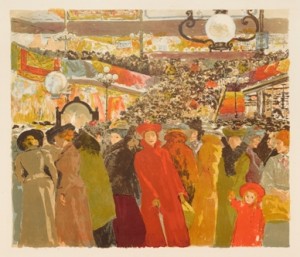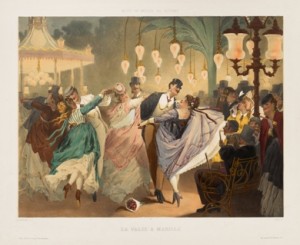
Alexandre Lunois, The Department Store (Le Bon Marché), 1902. Sterling and Francine Clark Art Institute, 1990.14
(WILLIAMSTOWN, Mass.) – Electric Paris, a new exhibition exploring how artists depicted the changing appearance of interior and exterior spaces as the city transitioned from oil lamps to gas and electric lights, featuring works by Edgar Degas, Henri de Toulouse-Lautrec, Pierre Bonnard, and others, opens at the Sterling and Francine Clark Art Institute on Sunday, February 17, 2013, and runs through Sunday, April 21, 2013.
Drawn primarily from the Clark’s collection, the exhibition includes paintings, prints, drawings, and photographs from high art and popular culture. It also includes images by Mary Cassatt, Édouard Vuillard, Maurice Prendergast, and other artists working in Paris in the late 19th century. Former Clark Fellow S. Hollis Clayson is guest curator for the exhibition.
Artists have long been interested in the effects of light and lighting, and the impact of the expanded use of gas – and later, electric – lighting on Paris’s public and private interiors did not go unnoticed by those living and working in the city in the second half of the nineteenth century. While the nickname “The City of Light” first arose in the eighteenth century when Enlightenment philosophers made Paris a center of ideas and metaphorical illumination, the moniker’s significance was later extended to create an association with the blaze of lights that had begun to illuminate the streets and boulevards of the French capital.
In the 1840s, Paris was one of the first cities to experiment with electric street lighting, and a huge increase in gas light in the 1850s secured the capital’s reputation as “The City of Light.” By the 1880s, electricity began to illuminate high-profile boulevards, and culminated in the widespread installation of incandescent electric street lighting across the city in the early decades of the twentieth century.
Parisian entertainment entrepreneurs were leaders in the use of new lighting technologies in the late 1880s. Venues such as theaters, cafés, circuses, and nightclubs were among the first to experiment with trendy and brilliant forms of lighting. Drawn to the excitement and aesthetic possibilities offered by these dramatic, glaring, and often lurid environments, artists such as James Tissot, in The Ladies of the Chariots, depicted the spectacle of these venues. His etching of the Hippodrome de l’Alma shows extravagantly costumed equestrian performers awash in a piercingly white glow of electric arc lights.

Gustave Barry and Philippe Jacques Linder, Waltz at Mabille, c. 1860-70. Sterling and Francine Clark Art Institute, 1955.2476
Jarring contrasts and excessive light often appeared in pictures that recorded the crass, raucous side of modern public life. In Gustave Barry’s Waltz at Mabille, a multitude of bright teardrop-shaped gas lights hang above the unseemly dancers — dandies, courtesans, and students among them — of the Bal Mabille. Meanwhile, Alfred Maurer uses the unexpected contrasts between different light levels caused by the combination of gas and electric lights to define the tawdry character of The Bal Bullier.
Other artists, notably Edgar Degas, focused on the thresholds between on- and off-stage areas and the ambiguity of these transitional spaces. In Entrance of the Masked Dancers, two dancers are seen standing in the shadows offstage, while a few feet away a line of performers is brilliantly illuminated. Although the different physical spaces are clearly separate, the boundaries between them are defined only by varying light levels, and are easily crossed.
As seen in Norbert Goeneutte’s Marguerite Gachet (Reading at Night), oil and gas lights, usually associated with privacy and the shelter of family, were the preferred lighting in bourgeois homes well into the 1890s despite the growing use of electric light in public spaces. But these old-fashioned sources were being replaced by brighter and more obtrusive ones, which advanced the spread of brilliant lighting into the home and redefined the traditional lamplit interior as a psychologically fraught, sometimes troubling environment. Such an environment is echoed in each of the three prints from Édouard Vuillard’s 1899 series Landscapes and Interiors, in which petroleum lamps play a dominant role. The fixtures are as elaborately ornamented as the wallpaper, and their illumination ignites colors and patterns that fill the room, while the small figures are dwarfed, blocked, or thrown into shadow.
Bright, steady electric light also played an important role in promoting consumer culture. In The Shop Window by Théophile Alexandre Steinlen, a woman carrying a large hatbox gazes longingly into the illuminated window, the desire for the goods on display evident on her face. Alexandre Lunois depicts the cavernous space of Le Bon Marché, Paris’s first department store, as bright and evenly illuminated by arc lights — assuring that despite the capacity crowd, the goods for sale would be highly visible.
Many artists continued to depict the new light as harsh and threatening, perhaps longing for the golden glow of the gaslight era. In Pierre Bonnard’s Street at Evening in the Rain, bands of yellow light reach into the square from the surrounding buildings, backlighting and simplifying the shapes of carriages and passersby. Aside from a woman in the foreground, individuals are difficult to distinguish. The effect suggests that rather than helping pedestrians and traffic move through the street, the electric light — along with the rain — makes them hurried and anxious.
The Clark is located at 225 South Street in Williamstown, Massachusetts. The galleries are open Tuesday through Sunday from September through June (daily in July and August), 10 am to 5 pm. Admission is free November through May; free year-round for Clark members, children 18 and younger, and students with valid ID; and $15 June 1 through October 31. For more information, call 413 458 2303 or visit Sterling and Francine Clark Art Institute.
